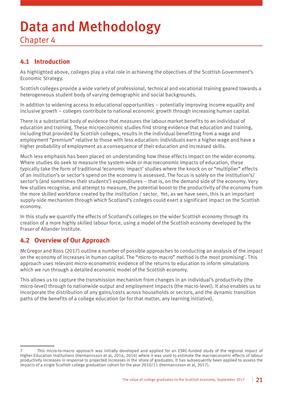
21
The value of college graduates to the Scottish economy, September 2017
4.1 Introduction
As highlighted above, colleges play a vital role in achieving the objectives of the Scottish Government's
Economic Strategy.
Scottish colleges provide a wide variety of professional, technical and vocational training geared towards a
heterogeneous student body of varying demographic and social backgrounds.
In addition to widening access to educational opportunities - potentially improving income equality and
inclusive growth - colleges contribute to national economic growth through increasing human capital.
There is a substantial body of evidence that measures the labour market benefits to an individual of
education and training. These microeconomic studies find strong evidence that education and training,
including that provided by Scottish colleges, results in the individual benefitting from a wage and
employment "premium" relative to those with less education: individuals earn a higher wage and have a
higher probability of employment as a consequence of their education and increased skills.
Much less emphasis has been placed on understanding how these effects impact on the wider economy.
Where studies do seek to measure the system-wide or macroeconomic impacts of education, these
typically take the form of traditional 'economic impact' studies where the knock on or "multiplier" effects
of an institution's or sector's spend on the economy is assessed. The focus is solely on the institution's/
sector's (and sometimes their students') expenditures - that is, on the demand side of the economy. Very
few studies recognise, and attempt to measure, the potential boost to the productivity of the economy from
the more skilled workforce created by the institution / sector. Yet, as we have seen, this is an important
supply-side mechanism through which Scotland's colleges could exert a significant impact on the Scottish
economy.
In this study we quantify the effects of Scotland's colleges on the wider Scottish economy through its
creation of a more highly skilled labour force, using a model of the Scottish economy developed by the
Fraser of Allander Institute.
4.2 Overview of Our Approach
McGregor and Ross (2017) outline a number of possible approaches to conducting an analysis of the impact
on the economy of increases in human capital. The "micro-to-macro" method is the most promising7. This
approach uses relevant micro-econometric evidence of the returns to education to inform simulations
which we run through a detailed economic model of the Scottish economy.
This allows us to capture the transmission mechanism from changes in an individual's productivity (the
micro-level) through to nationwide output and employment impacts (the macro-level). It also enables us to
incorporate the distribution of any gains/costs across households or sectors, and the dynamic transition
paths of the benefits of a college education (or for that matter, any learning initiative).
7 This micro-to-macro approach was initially developed and applied for an ESRC-funded study of the regional impact of
Higher Education Institutions (Hermannsson et al, 2014, 2016) where it was used to estimate the macroeconomic effects of labour
productivity increases in response to projected increases in the share of graduates. It has subsequently been applied to assess the
impacts of a single Scottish college graduation cohort for the year 2010/11 (Hermannsson et al, 2017).
Data and Methodology
Chapter 4